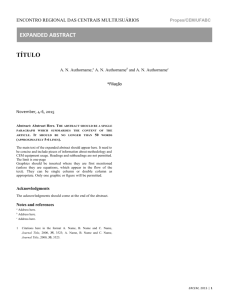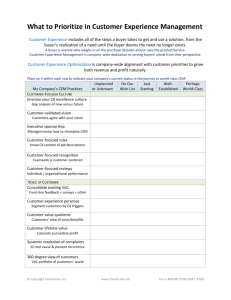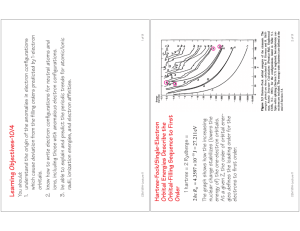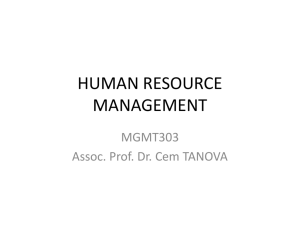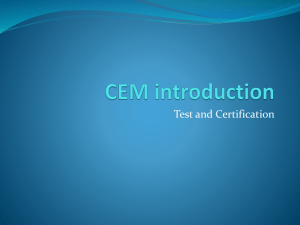CEM: There's no one “right” solution TextStart By Trevor Cheung
advertisement
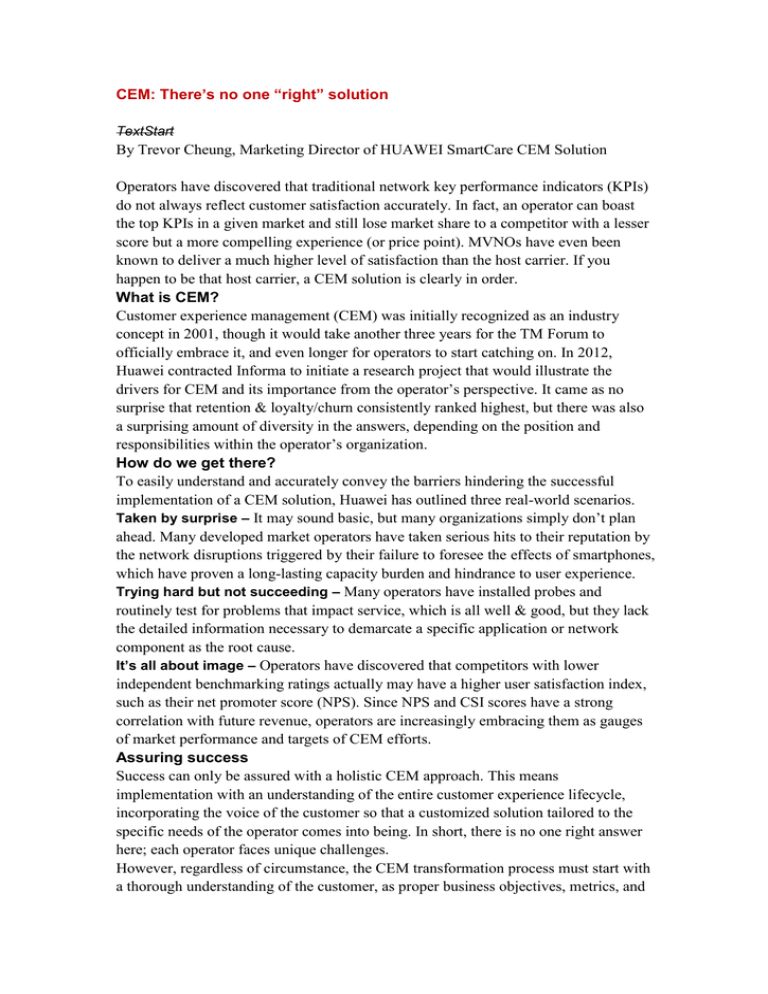
CEM: There’s no one “right” solution TextStart By Trevor Cheung, Marketing Director of HUAWEI SmartCare CEM Solution Operators have discovered that traditional network key performance indicators (KPIs) do not always reflect customer satisfaction accurately. In fact, an operator can boast the top KPIs in a given market and still lose market share to a competitor with a lesser score but a more compelling experience (or price point). MVNOs have even been known to deliver a much higher level of satisfaction than the host carrier. If you happen to be that host carrier, a CEM solution is clearly in order. What is CEM? Customer experience management (CEM) was initially recognized as an industry concept in 2001, though it would take another three years for the TM Forum to officially embrace it, and even longer for operators to start catching on. In 2012, Huawei contracted Informa to initiate a research project that would illustrate the drivers for CEM and its importance from the operator’s perspective. It came as no surprise that retention & loyalty/churn consistently ranked highest, but there was also a surprising amount of diversity in the answers, depending on the position and responsibilities within the operator’s organization. How do we get there? To easily understand and accurately convey the barriers hindering the successful implementation of a CEM solution, Huawei has outlined three real-world scenarios. Taken by surprise – It may sound basic, but many organizations simply don’t plan ahead. Many developed market operators have taken serious hits to their reputation by the network disruptions triggered by their failure to foresee the effects of smartphones, which have proven a long-lasting capacity burden and hindrance to user experience. Trying hard but not succeeding – Many operators have installed probes and routinely test for problems that impact service, which is all well & good, but they lack the detailed information necessary to demarcate a specific application or network component as the root cause. It’s all about image – Operators have discovered that competitors with lower independent benchmarking ratings actually may have a higher user satisfaction index, such as their net promoter score (NPS). Since NPS and CSI scores have a strong correlation with future revenue, operators are increasingly embracing them as gauges of market performance and targets of CEM efforts. Assuring success Success can only be assured with a holistic CEM approach. This means implementation with an understanding of the entire customer experience lifecycle, incorporating the voice of the customer so that a customized solution tailored to the specific needs of the operator comes into being. In short, there is no one right answer here; each operator faces unique challenges. However, regardless of circumstance, the CEM transformation process must start with a thorough understanding of the customer, as proper business objectives, metrics, and a service/customer-centric orientation cannot be selected without it. A partner is needed here, one with global experiences and local CEM insights, one who can help an operator achieve its goals within a reasonable amount of time, on any scale desired. Huawei CEI Surveys are the most commonly accepted method for assessing customer loyalty or determining an NPS, but they tend to attract only the extreme answers. More is needed here, and Huawei revolutionizes the customer assessment process with its customer experience index (CEI), a quality of experience (QoE) measurement that is purely objective. The main difference between CEI and NPS is that the latter incorporates emotional and psychological factors, such as branding or imaging, while CEI does not, as it involves the tracking of user behavior, and can be used to cross-check the truthfulness of individual survey results. The path is clear Although CEM was developed to address the shortcomings of a pure KPI approach, a successful customer-centric operation can only be assured if network performance is up to par. This makes network and service quality improvement the initial and most critical phase of any successful CEM implementation. Once satisfactory network performance is achieved, service quality monitoring activities can begin. With the Huawei SmartCare CEM solution, service quality improvement is based on an E2E per-service per-user (PSPU) KQI system that monitors service quality, demarcates problems, and accurately determines root causes, so that a KQI optimization plan can be formulated. Operational consulting involves advice on how to reduce costs, increase efficiency, and achieve operational best practices that focus on improved user satisfaction; this is accomplished by addressing four key areas. The first is business process management, as it dramatically impacts the performance of any company and differentiates any organization from its competitors, while the second is organization and competence management, which evaluates staff competence and current organizational structure to ensure that they align with corporate goals. Operational benchmarking is the third and provides real-time performance analysis that allows telcos to compare their operations against competitors. And finally, change management facilitates the transition of individuals or teams within organizations from a current to a desired mode of operations. As operations move to customer centricity, carriers must hire and retain talent with an entirely different skill set for the service operations center. During this transition, the operator will require the guidance of a CE consulting team that supports them through the various challenges they will encounter. The first step in defining the customer experience is journey mapping, which is simply illustrating the steps a customer goes through when interacting with the operator. Next, an assessment maturity model is utilized to ensure consistent, predictable, efficient, and reliable assessment deployment. Operators need to address the importance of properly managing and providing experience assurance in terms of the entire customer lifecycle, as this is critical to retaining high-value subscribers. As mobile phone penetration increases, the acquisition of new subscribers becomes increasing challenging. It is imperative that operators adopt a CEM model to upsell services and increase loyalty, as this has the added benefit of preventing an organization from wasting valuable time and money constantly acquiring potentially less-profitable subscribers. Huawei offers a holistic CEM solution that is more than just a product or platform. With our deep understanding of the telecommunications industry, coupled with our strong strategic commitment to providing the ultimate in CEM solutions, the results are undeniable. Huawei’s award-winning R&D capabilities have enabled us to develop our own state-of-the-art solution that includes the probes, software, and services necessary to address the individual needs of any operator. Our internationally-recognized team of global consultants can guide operators through the challenges of customer centricity, putting us in a unique position, as no other vendor can make that claim. TextEnd
